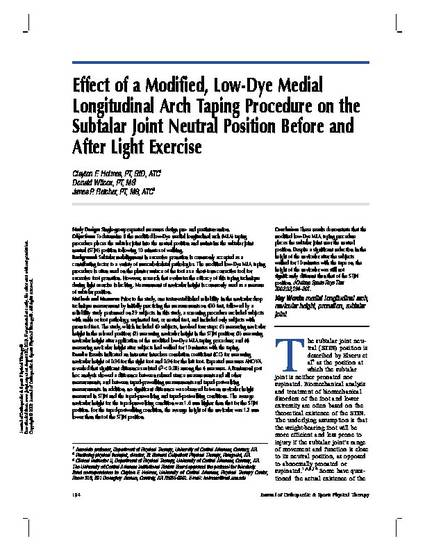
Article
Effect of a Modified, Low-Dye Medial Longitudinal Arch Taping Procedure on the Subtalar Joint Neutral Position Before and After Light Exercise
Journal of Orthopaedic and Sports Physical Therapy
(2002)
Abstract
Study Design: Single-group repeated measures design pre- and postintervention.
Objectives: To determine if the modified low-Dye medial longitudinal arch (MLA) taping
procedure places the subtalar joint into the neutral position and maintains the subtalar joint
neutral (STJN) position following 10 minutes of walking.
Background: Subtalar malalignment in excessive pronation is commonly accepted as a
contributing factor to a variety of musculoskeletal pathologies. The modified low-Dye MLA taping
procedure is often used on the plantar surface of the foot as a short-term corrective tool for
excessive foot pronation. However, research that evaluates the efficacy of this taping technique
during light exercise is lacking. Measurement of navicular height is commonly used as a measure
of subtalar position.
Methods and Measures: Prior to the study, one tester-established reliability in the navicular drop
technique measurement by initially practicing the measurements on 400 feet, followed by a
reliability study performed on 29 subjects. In this study, a screening procedure excluded subjects
with ankle or foot pathology, supinated feet, or neutral feet, and included only subjects with
pronated feet. The study, which included 40 subjects, involved four steps: (1) measuring navicular
height in the relaxed position; (2) measuring navicular height in the STJN position; (3) measuring
navicular height after application of the modified low-Dye MLA taping procedure; and (4)
measuring navicular height after subjects had walked for 10 minutes with the taping.
Results: Results indicated an intrarater intraclass correlation coefficient (ICC) for measuring
navicular height of 0.96 for the right foot and 0.94 for the left foot. Repeated measures ANOVA
revealed that significant differences existed (P ! 0.05) among the 4 measures. A Bonferroni post
hoc analysis showed a difference between relaxed stance measurements and all other
measurements, and between taped-prewalking measurements and taped-postwalking
measurements. In addition, no significant difference was observed between navicular height
measured in STJN and the taped-prewalking and taped-postwalking conditions. The average
navicular height for the taped-prewalking condition was 1.6 mm higher than that for the STJN
position. For the taped-postwalking condition, the average height of the navicular was 1.2 mm
lower than that of the STJN position.
Keywords
- Subtalar Joint,
- Pronation,
- Measurement,
- Exercise,
- Medial longitudinal arch,
- athletic taping
Disciplines
Publication Date
Spring May, 2002
Citation Information
Clayton Holmes, Don Wilcox and James C. Fletcher. "Effect of a Modified, Low-Dye Medial Longitudinal Arch Taping Procedure on the Subtalar Joint Neutral Position Before and After Light Exercise" Journal of Orthopaedic and Sports Physical Therapy Vol. 32 Iss. 5 (2002) p. 194 - 201 Available at: http://works.bepress.com/don-wilcox/2/
